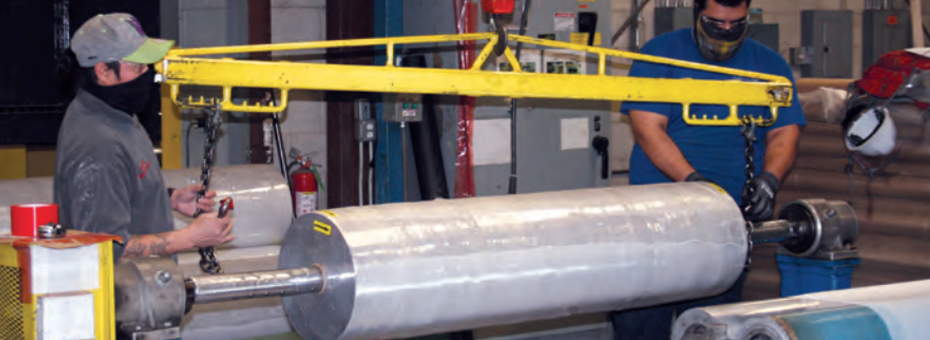Contrary to what some media outlets have reported, lean management principles didn’t fail during the pandemic; some companies failed to execute them correctly, according to Mark Reich, a senior coach at the Lean Enterprise Institute.
Mark dispelled misunderstandings about lean and just-in-time production in this Q&A in Specialty Fabrics Review, the main publication of the Industrial Fabrics Association International, a large trade group. For instance, a common misconception was that lean meant holding zero or near-zero levels of inventory. Actually, it required optimal levels that are constantly monitored and adjusted using a technique called “leveling,” Mark noted.
The interview was part of the March 2021 story, A Path Forward that examined how a variety of companies in the specialty fabrics marketplace responded to the pandemic’s disruptions. The Q&A follows. Read the entire story here or near the top of our In the News page.
Q: Lean manufacturing principles are built on the concept of smooth, stable product demand and supply chains free of significant disruptions, correct?
A: Lean management does rely on stable and smooth demand to be most successful. When demand is unstable and uneven, the concept of heijunka, or leveling, helps us smooth production. Let’s say you can make 500 products a day. But you get an order for 700 one day, 1,000 another day, then 200 and 300 other days, etc., but your average demand is 500. Heijunka says to hold just enough inventory to be able to cover fluctuations. What happens in these cycles is that orders total, say, 700 one day and the next fall back to 300. So, you still make 500 but you put 200 in inventory to cover the next fluctuation. You don’t do that arbitrarily. Over time, you must study what the real average demand is to know the minimum number of items to hold in inventory.
You hold two kinds of inventory. Buffer stock covers fluctuations from outside customers. Safety stock covers issues inside your facility such as a piece of equipment that can’t produce [for some reason] or you run out of material because a supplier didn’t deliver. The benefit of leveling is that you don’t have to change your production pace or the number of team members. Lean makes the choice that we will try very hard to avoid managing fluctuations with labor modifications in hiring, laying off people or moving people between production lines, etc. Instead, we’ll manage inventory to meet demand fluctuations as our first step before disrupting the workforce.
Q: How did the pandemic test lean principles?
A: Everything goes out the window in a situation like the pandemic. If you made masks or ventilators, for example, you made a certain volume until now when suddenly you need 100 times the volume. You’re going to have to add people, equipment, and production shifts. It doesn’t make sense to design production systems or stockpile inventory with the idea that once in a century you’ll have to contend with a pandemic. But lean principles still will help. The lean practice of total productive maintenance ensures that every machine can always perform its required tasks. Lean also encourages cross-training employees so they can move to produce what’s needed.
Q: Some may think lean principles failed the pandemic challenge. What are they getting wrong?
A: I don’t think lean principles failed, but some companies failed to execute them. If introduced purely as a cost-cutting measure and a way to cut the number of people, lean management isn’t going to be applied effectively. Plus, unfortunately, many companies view lean only as inventory management. There are two problems with this.
First, some people are portraying just-in-time production purely as inventory management, which it isn’t. Secondly, people are subsequently portraying lean as purely just-in-time. We need to go back to the fundamental principle of just-in-time— providing a high-quality product to the customer in the shortest lead time based on demand. The managing of inventory (including the misperception that this means zero or near-zero inventory) is merely one of many methods to support just-in-time. In fact, because our focus is on the customer, if we cannot deliver to that just-in-time way of thinking, we’re not lean. This is the question we need to answer, not how low or high is our inventory.
Having said all that, what lean does challenge us to do is consider that we have traditionally held “excess” inventory to cover wastes in our system. But lean or TPS never said don’t hold inventory—that’s a major misinterpretation of lean thinking and practice. Just-in-time is an important component of lean, but it’s only one component. Lean management isn’t a static system. Yes, there are core principles we should never abandon, such as focusing on providing the most value to the customer. But the pandemic has given us an opportunity to reflect on lean management and use this opportunity to adjust.
EDITOR’S NOTE Mark Reich is a senior coach at the Lean Enterprise Institute (LEI), a Boston-based nonprofit that helps companies improve through lean thinking and practices, eliminating waste-creating activities and delivering high value for customers, using the fewest possible resources. Before joining LEI, Reich spent 23 years at Toyota Japan and North America, most recently as general manager of the Toyota Production System Support Center. During his time as general manager, Reich directly implemented the Toyota Production System (TPS) or managed its implementation in various industries.
Keep Learning
- Lean management maven and best-selling author Jeff Liker disabuses (again) The Wall Street Journal of its mistaken notions about just-in-time production. Read and post a comment.
- Help your team learn what lean management is and isn’t by subscribing to the Virtual Lean Learning Experience (VLX). An Annual Enterprise Subscription gives them (and you) a full year of unlimited access to accurate and authoritative seminars, practical exercises, and on-demand recordings of all VLX presentations to everyone at your organization. Individuals who register for the Annual Single-User Subscription gain the same benefits for themselves. The next seminar starts June 21, 2021. Learn more and subscribe.






